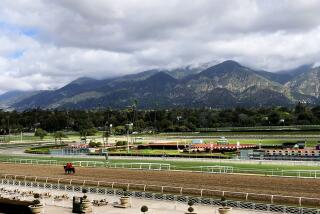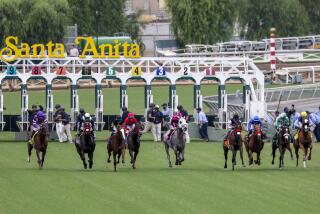Worried About Wind : Conner Sails Around Backing S.D. for Races
- Share via
America’s Cup victor Dennis Conner faced the press in San Diego Tuesday and those seeking a ringing endorsement for his hometown as the site of the next Cup regatta went away disappointed.
What they received instead was straight talk from the skipper, a business-like explanation that despite the obvious hometown emotions, what’s most important is a successful Cup defense, whether it’s in San Diego or somewhere else.
In doing so, Conner made his most direct response yet to persistent questions of where he would like the 1991 races to be held. The final decision will be made by a committee to be selected in a few weeks.
“I’m from San Diego. I live in San Diego. I’d love to see it in San Diego. I grew up here, my friends are here, I’m a commodore of the yacht club, this is my life, everything I owe comes from this community, but I also see the whole picture,” Conner said during a San Diego Press Club luncheon at the Horton Grand Hotel.
“I’m an American and America helped win this. A broad base of the technology came from America, the bulk of money came from America. Frankly, less than 10% of the money we spent came from San Diego,” he said.
“I’m thrilled to have everybody’s support and commitment (in) San Diego. This would be a great place to sail the event . . . but the question of the site . . . is a very, very complex one. It’s one that could ultimately affect the whole future of the America’s Cup.”
Conner said that he, along with Sail America--the syndicate that sponsored his victorious Stars & Stripes boat--and the San Diego Yacht Club have a “fiduciary responsibility to all of America to defend the Cup successfully.”
“I think that’s one of the questions we all should worry about . . . I admit, I’m a little prejudiced, but I think this more important than someone (who) has a boat in a marina that likes to go out and watch it . . . .
“I can appreciate they may not be coming from the same place that Dennis is. They want to . . . see it here in San Diego. I feel a responsibility defending this successfully for America.”
Conner said that if San Diego failed to adequately host the defense, it would be an embarrassment to the community. “It’s a very, very complicated issue, “ he said. “It’s not just a matter of emotion.”
Conner noted that he and Stars & Stripes have a competitive advantage over the rest of the world in heavy-wind sailing conditions, which prevailed in Australia.
“Our edge is in strong winds. Now if we have to defend this in light air (which San Digo is noted for), we’re just one of the pack starting all over again,” he said. “From an operational standpoint all of our boats (would be) worth nothing . . . we certainly would be throwing away a tremendous asset from an equipment standpoint.”
Conner made made no reference to it but among the sites vying for the next Cup races is Hawaii, renowned for strong winds. Conner and his crew trained in Hawaii for the races in Fremantle, Australia.
While Conner talked of the danger of losing his boat’s strong-wind advantage, others have said it’s already gone. Within days of Conner’s victory in February, Stars & Stripes’s designers declared it obsolete, calling it a victim of rapidly advancing technology.
Sandy Purdon, Sail America executive director, told The Times he disagrees with Conner. He said knowledge learned in designing Stars & Stripes as a strong-wind boat can be transferred to the development of a light-air boat. Purdon also said that advancing technology has erased the edge Conner had in Australia and all competitors in the next races will be starting anew.
Conner said another important factor in picking the site of the next races will be the financial packages offered by those areas seeking the races. Conner said that the state of California would be a major beneficiary of what he estimated at a $1-billion infusion into the economy during the 3 1/2 years of race preparations and the races themselves and should help provide funding.
The effort to bring the Cup defense to San Diego is being led by a task force headed by Supervisor Brian Bilbray. It is working with the San Diego Unified Port District, considered the key public agency because it controls tidelands where America’s Cup facilities would be constructed. The task force includes prominent business leaders such as Gordon Luce, head of Great American First Savings Bank.
The task force has yet to say what the Cup defense would cost San Diego and a detailed proposal is still a few months away.
Conner estimated it will cost about $100 million to defend the Cup. That is money that would be raised to partially fund the design, preparation and construction of defending boats for both Conner and other American syndicates.
“I’m saying that somehow, someway, Dennis and Sail America . . . have to come up with the money to fund the defense,” Conner said. “If we can only come up with $5 million, we’re not going to do a very good job. If we can come up with $50 million, we’re going to do a better job.”
Conner said he envisions both more spending by sailing syndicates, and more syndicates in the 1991 races.
He noted that West Germany--which he called extremely formidable--Japan, Switzerland, Sweden, Denmark and Spain will probably join in the next competition. He said that countries in the Middle East and even the East European bloc have expressed interest.


